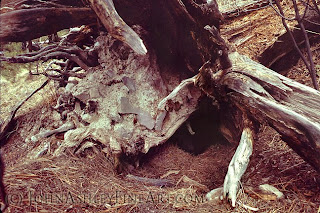 |
| Wildlife Biology student volunteers at the National Bison Range |
To avoid bison encounters, you are required to stay by your car when touring the National Bison Range -- unless you're a bunch of greenhorn wildlife biology students who volunteer to work during spring break. One chilly morning twenty-something years ago, two truckloads of us lumbered up Red Sleep Mountain, starting at the top so we could fan out and hike downhill in all directions.
Our job? Count how many deer, elk and sheep survived winter on the Range. My assignment was to hike along this skinny ridge, and then drop down into its steep draw, on down the mountain to the perimeter road and the rendezvous truck.
 |
| Black bear den at Nat. Bison Range |
Reaching the roots, I almost lost my breath instead.
 |
| Black bear peering out of its den |
A black bear sow breeds in summer, but she delays embryonic implantation until December -- one or two months after she dens up. Her cubs are born in late January or early February. They arrive naked and blind in the middle of winter, and they do not hibernate. They'll nurse and grow fast, keeping warm by cuddling with mom. Tipping the birth scales at 8-12 ounces (224-336g) and 8 inches (20 cm) long, the youngsters will emerge three months later at a flyweight 4-8 pounds. (Grizzly cubs emerge at about twice that weight.) Slightly more than one-third of western Montana's black bear cubs will survive their first year.
Our black bears are comparative light-weights, which shows the difficulty they have finding enough food. Males in the northwest average about 175-200 pounds, while acorn-fattened eastern bears can weigh up to 600-800 pounds. Bears living in the Rattlesnake Wilderness Area, north of Missoula, have learned to come into town at night to harvest apples in the fall. But in winter, about the only way to beat starvation is by hibernating.
Black bears get ready for hibernation during the fall feeding frenzy, when they'll consume five times more calories and build up a five inch layer of fat. In late fall, these fat cells secrete an appetite-diminishing hormone, leptin, and the bears gradually stop eating. They'll enter the den on empty stomachs without the pangs of hunger. In spring, leptin levels decrease and hunger returns.
Just how they metabolize those fat cells is one of the secrets to bear hibernation.
People can survive a long time on body fat alone. But metabolism generates nitrogen, which our bodies convert into toxic urea, and so we must continually drink and excrete water to get rid of nitrogen. If we stopped drinking, we would die of dehydration. If we stopped urinating, we would become poisoned by our own metabolic wastes.
Bears, on the other hand, don't drink or urinate in winter. Their winter metabolism also creates nitrogen, but their bodies recycle that nitrogen into muscle and organ tissues. They do generate a small amount of urea, but they convert it into non-toxic creatine. No toxins produced means no need to drink or urinate while denning.
Another secret to bear hibernation is how they maintain bone density while remaining inactive for months on end. Human astronauts quickly loose bone mineral content in space, unless they exercise, and paraplegics lose 30% of pre-injury bone mass. How does a bear that sleeps for five months prevent bone density loss? We don't exactly know.
But some previously hidden hibernation secrets are slowly coming into view -- potentially including the birth of black bear cubs.
A bear research group in Ely, Minnesota has installed a live, web-streaming camera at the den site of "Lily," one of their research bears. Lily is three years old and thought to be pregnant. While she's not a Montana bear, and not exactly wild, she might give us the opportunity to watch the world's first live bear birth. You can check in on Lily by clicking here.
If Lily does have cubs, then you might just find that watching them grow in their winter den is an irresistable, unexpected bear encounter.
-----------------------------------------------------------------------------------------------
1/22/10 UPDATE
Lily the black bear is now a mom.
Lily gave birth to a single cub on Friday, January 22nd, after more than 21 hours of labor. Now she's alternating her time between sleeping and and feeding her tiny cub. We should be able to watch the cub grow up in the den for the next two to three months. It will be fascinating to watch as Lily lifts the veil on more black bear secrets.
-----------------------------------------------------------------------------------------------
3/31/10 UPDATE
Lily and Hope left their den today. You can still read updates on their progress and watch video highlights at the link above.

